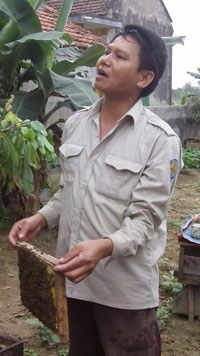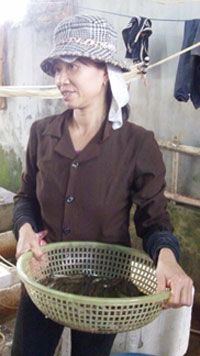
Well-fed women smile out from under their hats as they pull in their catch of fish, shrimp and crabs from the mangrove forest. The simple images are in an educational booklet on the benefits of mangroves, with tips on how to grow seedlings. While the real mangrove on the outskirts of Dai Hop Commune in northern Vietnam looks somewhat different from the one drawn in the book (none of the trees are waving to me, for one thing), the people I met living there were as effusive about its benefits on their lives, as those smiling ones in the booklet.
The mangroves are helping Dang Than Tung earn a good income. He is an apiarist (beekeeper to you and me) with 40 bee hives. The flowering mangrove provides his bees with nectar and pollen and they, in turn, help pollinate the mangroves in a symbiotic interaction. He makes around US $10 from every litre of honey harvested. With each hive producing around 10 litres per year, he’s earning around US $4,000 from his hives. That’s about as much as he earns from farming, but for far less work. No wonder he’s thinking of expanding his beekeeping next year.

Dan Thanh Tung tending a beehive.
Many locals – mostly women – from the community planted the mangrove seedlings, so it seems only right that they are also benefiting financially from their hard work. I met Nguyen Thi Nhung and Nguyen Thi Son during the 6th International Conference on Community-based Adaptation to Climate Change, which is an opportunity for researchers and project managers to share and learn about what local actions can protect communities from the effects of climate change, such as rising sea temperatures and unpredictable weather events. Both women fish with around 50 or 60 women each day in the mangrove using small hand traps. They say the group of fisherwomen catches anywhere between 200 kg to 1000 kg of fish and other seafood each day, with an average catch of 500 kg. They sell the fish locally and to Chinese traders, earning them each a minimum of around US $25 per day, providing them with important additional income for their family.

Nguyen Thi Son with her latest catch.
While the mangroves are now hailed a success, planting them wasn’t. In fact they had to plant the mangroves three times because they weren’t adequately protected when in the early growing stages from people fishing in the area. In response they created specific routes for the fishing boats. The project managers also say communicating the potential benefits of the mangroves was key to their success. They talked to the men in the local committee, the women in the local union and then helped support an educational programme in the school focusing on disaster preparedness and on the benefits of the mangroves for the children and their families using educational resources with pictures such as the one posted on this blog.
Despite the early difficulties, the project seems to show that sometimes there really are win-win situations. A communities’ resilience to the impact of tropical storms is increased by planting the mangrove, and so are its profits.
